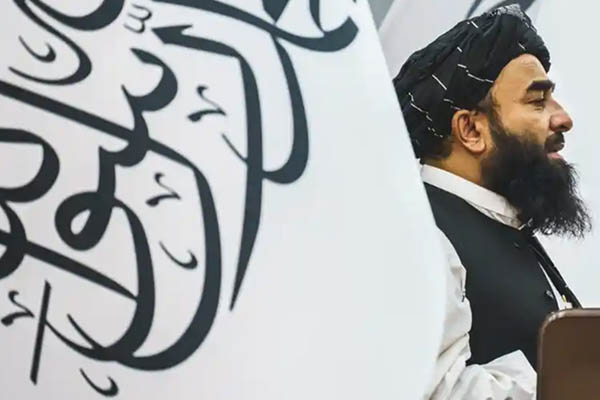
File photo of Taliban spokesman Zabihullah Mujahid with the flag of the Islamic Emirate
Pakistan is bitterly aware of what its citizen living near the Pak-Afghan border are going through thanks to recent cross-border terrorist attacks, but they may not be as aware of what Afghans—especially women—are suffering at the hands of their own government. For most Pakistanis, the “Afghan problem” is one of trespassing terrorists, with Kabul’s interim Taliban government failing to offer any counter as it rules over a state without any writ. What is often forgotten is that “invader” America spent $2.3 trillion there over two decades, with the “war on terror” causing the deaths of 2,324 American soldiers; 3,917 contractors and 1,144 allied troops. This is a fraction of what the Afghans suffered.
Following the invasion post-9/11, 70,000 Afghan military and police were slain alongside 46,319 civilians—an underestimation—and around 53,000 opposition fighters. The fallout of the conflict saw nearly 67,000 people killed in Pakistan. The exit of Western troops, however, has seen no let-up in the suffering. Economic losses resulting from the Taliban takeover of August 2021 have seen a third of Afghan households losing the ability to buy the food they need, with prevailing food insecurity exacerbated by a succession of drought-stricken harvests. The Taliban’s re-imposition of draconian social restrictions has also seen education wither, with Afghan households increasingly responding by expanding their—youths and adults alike—participation in the labor force, almost entirely in self-employment and home-based activities.
Amidst all this, the Taliban are more focused on tackling “social ills” rather than the economy. They have restricted women and girls from employment, education, public interactions and other fundamental rights such as access to justice. In the past year, the Taliban have broken from global trends to ensure gender equality by issuing several decrees and public statements on the status of women and girls, rapidly reversing two decades of hard-win progress. Almost half the women who were employed in 2019-20 have lost their jobs, while a ban on girls’ education continues and poses a significant threat to Kabul’s long-term economic development. The U.N. Refugee Agency has been sounding the alarm, noting that Afghans still make up the third-largest refugee population in the world, with an estimated 2.6 million registered Afghan refugees globally—2.2 million residing in Iran and Pakistan. “Afghanistan has returned to one of the darkest times in its history,” it warns. “The Taliban administrators have failed to rebuild Afghanistan thus far, making it difficult to govern. Its inability to form an inclusive government to provide girls and women with the right to education and work and its efforts to restrict people’s mobility have led to a new Afghan refugee crisis. This coupled with a continued drought has compounded the humanitarian crisis, increasing the number of people willing to flee, especially to the neighboring countries.”
